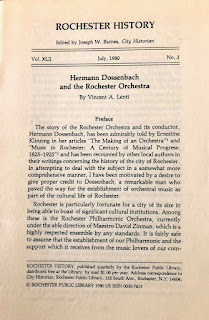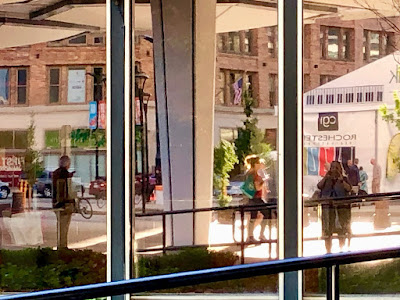 |
| Lisa, age 19 |
Perhaps this was the beginning. In 1976, I, a 19-year-old girl from Waterloo, NY, influenced by the TV Miniseries Roots and the national desire for genealogy that it stimulated, walked into the Genealogy Room on the 2nd floor of Rundel Library in downtown Rochester. I was shy, and I didn’t know how to begin. There, by the window, was a busy librarian, with books and papers cradled in one arm, while the other straightened out materials on a table.
 |
| Rundel Library |
I approached her and said in a tiny, high-pitched voice, “Umm, I’m just starting a genealogy, can you help me?” She did not look at me or interrupt her work, but quickly said, “Last name?”
I answered, my voice even higher-pitched, because I was unsure how to say it, “Dossenbach?” She stopped immediately, looked directly at me, “The conductor?”
I replied, “I think.”
Yes, perhaps that was the beginning.
 Over the next year, I collected genealogical info, and got a clear idea of what the librarian meant by her question, “The conductor?” Theodore and Hermann and Otto Dossenbach, my great-grandfather and great-granduncles, were famous musicians and conductors in late 19th and early 20th century Rochester. There were two Rochester History papers about them; there were photos and orchestra programs at Rundel.
Over the next year, I collected genealogical info, and got a clear idea of what the librarian meant by her question, “The conductor?” Theodore and Hermann and Otto Dossenbach, my great-grandfather and great-granduncles, were famous musicians and conductors in late 19th and early 20th century Rochester. There were two Rochester History papers about them; there were photos and orchestra programs at Rundel.
But after a short time, all this got pushed aside as I plunged into living life, with all its surges and ups and downs. Throughout the ensuing years, while I was married and raised two children, I studied biographies and storytelling, got some college degrees, wrote my Master’s Thesis on writing autobiographically, taught English and Literature at area colleges. And all along, while my mother told stories about what she remembered of the early days in Rochester, I wrote and wrote and wrote, about this and about that, in notebooks and stray pages. I often thought to myself that I should get back to the genealogy. But between my initial foray into the Rochester Library when I was 19 and the summer of 2013 when I finally decided to return to my Dossenbachs, 36 years flew by.
So maybe that moment in 1976 was not the beginning.
Maybe the beginning was that summer in 2013, when I sold my house, left my job, took the small inheritance I’d gotten from my mother who had passed away the previous year, and moved to Rochester, to my great-grandmother Nellie Dossenbach’s house, and began my book about the Dossenbachs.
After first arriving, I allowed myself, and my dogs, to wander all through Rochester, walking and walking and walking, staring in awe at the houses where they lived and the streets where they walked, and photographing and documenting my own experience of this glorious city. I fell in love with the City of Rochester.
 |
| George Eastman Museum |
I visited the George Eastman House and discovered thousands of photos and letters to sift through, and I sat in Mr. Eastman’s living room during the Sunday Musicales and imagined that I was listening to Hermann’s and Theodore’s Quintette, which played there, in Mr. Eastman’s home, for his grand parties and twice-weekly musicales from 1905 - 1919. I visited Rundel Library’s Local History Room again, and this time they had three scrapbooks of Hermann Dossenbach’s, donated by his daughter in 1980. I also visited U of R’s Rush Rhees Library, Eastman Theater, Eastman School of Music, Sibley Library, Damascus Temple, and Mount Hope Cemetery where the Dossenbachs are buried. I bought hundreds of local history books and memoirs at library book sales and flea markets, many of which mentioned my relatives. I joined writing groups and began to consider how to package information/stories for listeners. It was exhilarating and daunting all at the same time. My plan to spend a year on this project jumped to two years, then three, four, five, and now here in my sixth year, I am hoping to finish the book soon.
Eventually, I realized that the story is not just about my family, the Dossenbachs, but it is a much larger story, about the City of Rochester itself, its growth, its promise, its burgeoning musical scene. The Dossenbachs conducted and played in orchestras and bands in the decades before and after the turn of the 20th century, before most people experienced recorded sound, when music was “live,” and when all events had music.
They performed in Corinthian Hall, Convention Hall, Lyceum Theater, the Powers Building, Cook’s Opera house, to name just a few. They played their music in the living rooms of the wealthy; they taught Susan B. Anthony’s niece and Emily Sibley-Watson’s son; they were friends with David Hochstein.
 |
Dossenbach/Rochester Orchestra
Conducted by Hermann Dossenbach |
Gosh, they also played in the grand department stores of the times — Sibley, Lindsay & Curr, McCurdy & Norwell’s, Duffy-Powers; and in the grand hotels dotting the shores of Lake Ontario and Irondequoit Bay at Manitou Beach, Grand View, Island Cottage, Ontario Beach Park, Summerville, Windsor Beach, Sea Breeze, and Glen Haven. Rochesterians heard the Dossenbachs in Highland and Maplewood and Genesee Valley Parks, and in street dances where they played on a portable bandstand.
 |
The Rochester Park Band
Directed by Theodore Dossenbach |
The musical Dossenbachs entertained at the Auto Shows, the Lilac and Song & Light and River Festivals, for the orphans on Orphans Day, at the glorious Rochester Shakespeare Pageant with over 3,000 performers. Throughout the summer and fall, they were in all the parades, celebrating workers, and holidays, mourning those soldiers who would not return from WWI, and then celebrating those who did return.
The Dossenbachs — my Dossenbachs — provided the soundtrack to people’s lives. Their story is the story of the City of Rochester in those exciting, and turbulent, decades before and after the turn of the twentieth century.
And it occurs to me: Perhaps the beginning is here, right now, in my mind, with the idea as it gels and forms and becomes more and more clear.
Will this “beginning” keep shifting as I learn more and more?
Well, to begin a story, the storyteller simple chooses a beginning, determines where to start. Of course, there is, in fact, a beginning long before that beginning, and one before that. It goes on and on.
 |
| Suspension Bridge and Village, Niagara Falls, NY |
But, right now, I’m going to choose this particular beginning. It is the year 1872, and there is a family of German immigrants living in a little cottage at Suspension Bridge, Niagara Falls, NY. They are poor; they are musicians; and, at this very moment where we begin, a little boy named Otto, who is very talented with his violin, is about to be discovered by a music conductor and teacher from the City of Rochester, and the family will then be persuaded to move to Rochester.
And the rest is history, and it will be told.









































